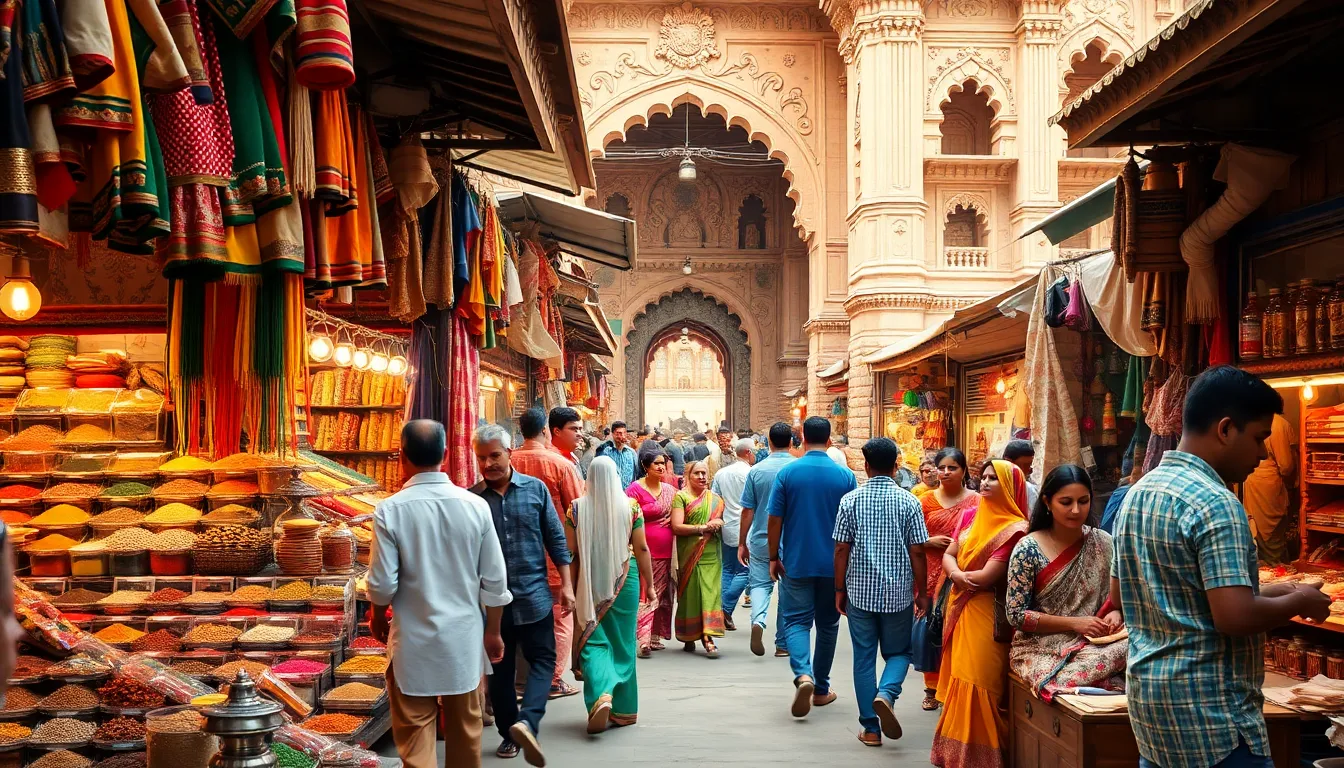India is a vibrant tapestry of cultures and languages, each thread woven with its own unique story. With over 1,600 languages spoken across the nation, figuring out what language Indian people speak can feel like trying to solve a Rubik’s Cube blindfolded. From Hindi to Tamil to Bengali, the linguistic diversity is nothing short of astounding.
Table of Contents
ToggleOverview Of Languages In India
India’s linguistic landscape showcases over 1,600 languages. This impressive number highlights the complexity of communication within the nation. Officially, the Constitution recognizes 22 languages in the Eighth Schedule, ranging from Hindi to Kannada.
Hindi stands as the most widely spoken language, with about 44% of the population using it as their first language. Bengali follows, spoken by approximately 8.1% of the population, primarily in the state of West Bengal and Bangladesh. Tamil represents another significant language, originating in the southern state of Tamil Nadu with a rich history and literature.
Other notable languages include Telugu, Marathi, and Urdu, each contributing to India’s multifaceted cultural identity. Regional languages often serve as primary means of communication in states, reinforcing local identities through dialects and variations. For instance, Punjabi is predominantly used in Punjab, while Gujarati thrives in Gujarat.
English plays a crucial role as a second language, serving as a bridge in business, education, and government communications. Approximately 10% of the population speaks English, often indicating urbanization and globalization. The linguistic diversity supports educational and professional opportunities, offering a unique environment for multilingualism.
Language boundaries occasionally blur as communities interact, leading to the emergence of pidgins and creoles. Consequently, India embodies a vibrant tapestry of languages that reflects its rich heritage and varying regional influences.
Major Languages Spoken

India’s linguistic diversity includes numerous major languages, reflecting the country’s vast cultural landscape. Below are key languages that shape communication across this vibrant nation.
Hindi: The Most Widely Spoken Language
Hindi ranks as the most widely spoken language in India, with approximately 44% of the population using it. Primarily, it flourishes in Northern states like Uttar Pradesh, Bihar, and Madhya Pradesh. This language serves as a primary medium for both formal and informal communication. Its extensive use in Bollywood films and popular music further solidifies Hindi’s cultural significance. Additionally, educational institutions frequently prioritize Hindi, often teaching it as a first or second language. Such factors contribute to Hindi’s status as a unifying linguistic force.
Bengali: The Second Most Spoken Language
Bengali stands as India’s second most spoken language, accounting for about 8.1% of the population. Its main presence is in West Bengal and Bangladesh, where it functions as a cultural cornerstone. Renowned for its literary heritage, Bengali boasts influential poets and writers, like Rabindranath Tagore. Moreover, the language is a vital medium in education, arts, and media. Social gatherings often spotlight Bengali, showcasing traditional music, dance, and cuisine, which enriches the community’s cultural identity. This language thrives through both formal and informal contexts, uniting its speakers.
Telugu: A Language Of The South
Telugu, one of the prominent Dravidian languages, holds significant importance in Southern India. Roughly 7% of the population speaks Telugu, especially in Andhra Pradesh and Telangana. Rich in history and culture, this language features an extensive literary tradition, with ancient texts and modern works. Additionally, Telugu cinema, commonly known as Tollywood, plays a crucial role in popularizing the language. Local festivals celebrate Telugu culture, emphasizing music, dance, and cuisine. With its flourishing presence in education and media, Telugu continues to thrive, connecting communities across the region.
Marathi: A Language Of Maharashtra
Marathi serves as the primary language of Maharashtra, spoken by around 7.1% of the population. This language embodies deep cultural roots, showcasing a vibrant literary heritage and notable poets. Government and education platforms frequently use Marathi, reinforcing its status in daily life. Festivals such as Ganesh Chaturthi prominently feature Marathi songs, dances, and theatrical performances, emphasizing communal identity. Furthermore, the language has a growing digital footprint, with online content expanding rapidly. Marathi reflects the state’s pride and cultural richness while connecting its speakers to their heritage.
Regional Languages And Dialects
India showcases an impressive array of regional languages and dialects, underscoring its cultural richness. Each language reflects distinct traditions and identities.
The Diversity Of Indian Languages
India is home to over 1,600 languages, revealing its linguistic variation. The Constitution recognizes 22 languages in the Eighth Schedule, underscoring their importance. Hindi dominates as the primary language, spoken by 44% of the population. Bengali and Telugu follow, with approximately 8.1% and 7% of speakers respectively. Marathi, with around 7.1% of speakers, also contributes to this linguistic diversity. Communities often use local dialects, adding further layers to the language fabric.
Influence Of Regional Cultures
Regional cultures significantly shape language use in India. Various festivals, art forms, and traditions influence the way languages evolve. For instance, Tamil’s literary richness owes to its ancient traditions, while Maharashtra’s Marathi reflects the state’s celebrations and history. Culinary practices also impact language, as dialects incorporate unique terminologies related to food. Additionally, cinema in regional languages bolsters cultural identity, attracting audiences and promoting local languages. Variations in pronunciation and vocabulary emerge as communities engage with one another.
Language And Identity In India
India’s linguistic diversity shapes its cultural identity. With over 1,600 languages spoken, each language reflects unique traditions and histories that contribute to the nation’s rich heritage.
The Role Of Language In Society
Language serves as a vital tool for communication within communities. It fosters connections among individuals and strengthens social cohesion. In India, regional languages permeate daily life, influencing everything from education to politics. Communities express their identities through language, which affects cultural practices and art forms. The prominence of Hindi in media and entertainment highlights its role as a unifying force. Meanwhile, local languages like Tamil and Bengali preserve cultural narratives, ensuring their stories endure through generations. These languages shape societal interactions and encapsulate the values held by diverse groups.
Language And Integration
Integration occurs through language exchange within India’s multicultural society. Hindi often acts as a bridge between speakers of different regional languages, promoting inclusivity. The shared use of English in business and education provides further opportunities for collaboration among diverse communities. Regional festivals often emphasize linguistic heritage, encouraging participation from various groups and strengthening bonds. Local dialects enrich communication, reflecting a tapestry of identities that coexist. As languages evolve through interaction, they create new forms that enhance social dynamics, showcasing India’s adaptive linguistic landscape.
India’s linguistic diversity is a testament to its rich cultural heritage. With over 1,600 languages spoken across the country each language contributes to the vibrant tapestry of Indian identity. The coexistence of major languages like Hindi and regional tongues such as Tamil and Bengali illustrates how language shapes community and culture.
As people continue to interact and exchange ideas through language the boundaries that separate these linguistic groups often blur. This dynamic evolution of language not only reflects India’s adaptability but also highlights the importance of preserving these unique identities. Ultimately the languages of India serve as vital links that foster connection and understanding among its diverse population.





